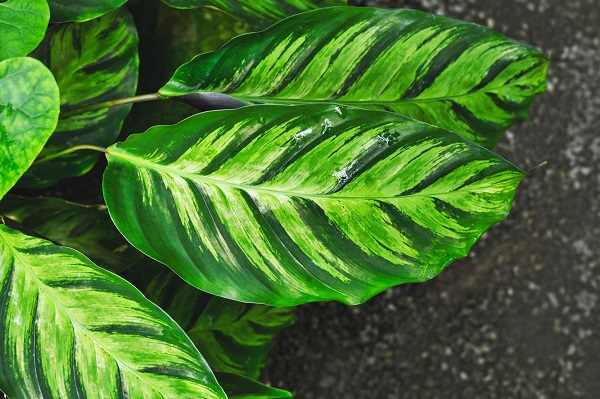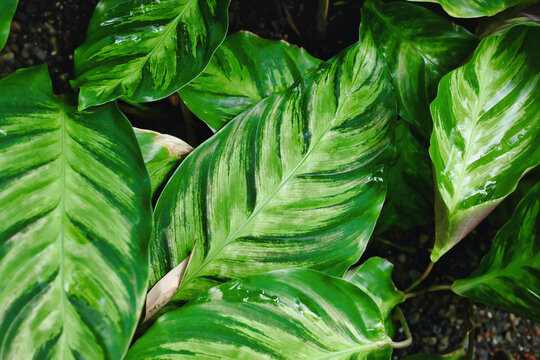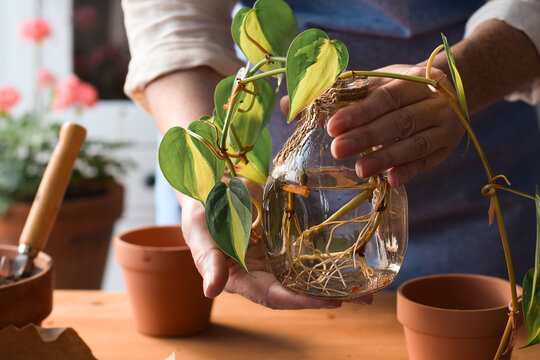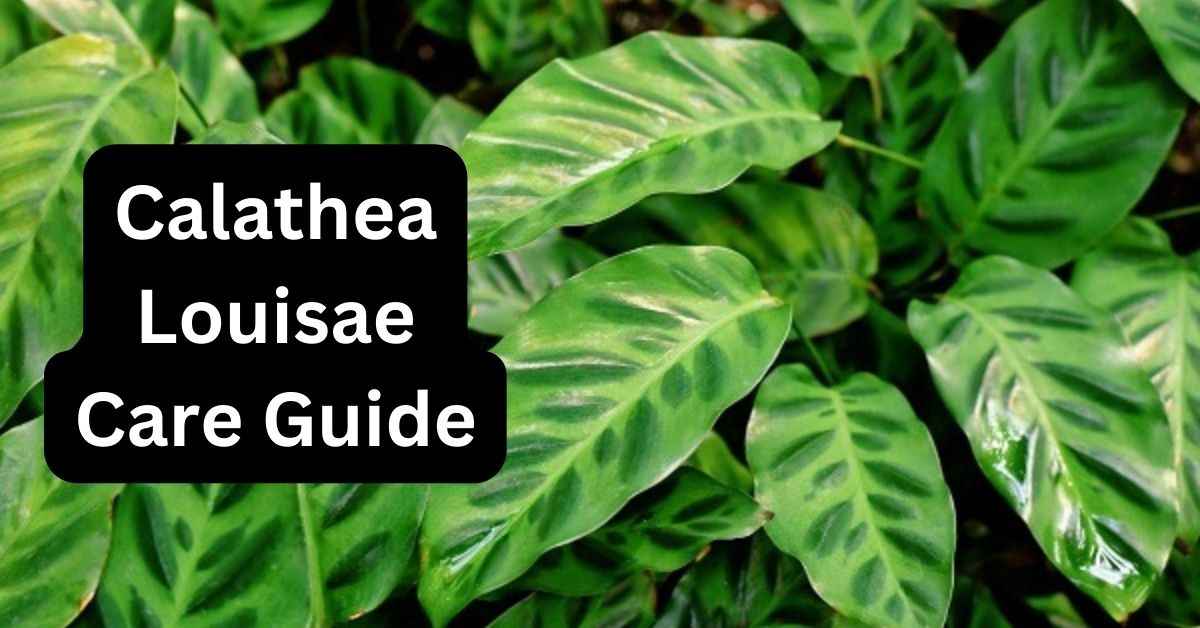Calathea Louisae is a really popularly grown calathea variety and it is most commonly known as Thai Beauty or Prayer Plant. The leaves of this plant are really ornamental, they have beautiful green and yellow stripes. Along with this, they have a unique purple underside.
Below is a perfectly organized guide to the care and maintenance of Thai Beauty. This plant has originated from the Brazilian rainforest, so for proper care, you must create conditions similar to the climate of a tropical jungle.
The temperature in tropical forests stays around 64˚F, and the humidity is extremely high. For Calathea Louisae care, regular watering, plenty of indirect sunlight is very important.
Post Contents
- Calathea Louisae Information:
- Calathea Louisae Care and Maintenance:
- Proper Light Requirements:
- Optimal Temperature and Humidity:
- Calathea Louisae Watering Needs:
- Soil Preferences:
- Propagation of the Prayer Plant:
- Calathea Louisae Fertilizing Requirements:
- Repotting and Pruning:
- Common Problems and Simple Fixes:
- Insect Attacks on Calathea Louisae:
- Frequently Asked Questions:
- Final Conclusion:
- Author
Calathea Louisae Information:
Explore the details of Calathea Louisae, including its name, family, native region, and care requirements.
| Information | Description |
|---|---|
| Common Name | Calathea Louisae |
| Scientific Name | Calathea louisae |
| Family | Marantaceae |
| Native to | Brazil |
| Growth Habit | Herbaceous perennial |
| Leaf Pattern | Lanceolate with pink stripes |
| Leaf Color | Dark green with pink undersides |
| Light | Bright, indirect light |
| Watering | Keep soil evenly moist |
| Humidity | Requires high humidity levels |
| Temperature | Prefers warm temperatures (18-26°C) |
Calathea Louisae Care and Maintenance:
Let’s dive into the detailed information about the caring tips, along with this you’ll learn some really enthralling facts about Thai beauty!

Proper Light Requirements:
Starting off with the basic need that is light, you have to meet the plant’s original tropical requirements. For this you have to find a suitable place for it. The place can be anywhere from your home, garden, or even a greenhouse. We recommend that you place this plant at a place and not move it too much.
When it comes to their habitat, the rainforest, they grow under shade of large trees with adequate light, but it’s indirect and shady. Create an environment similar to that when you’re growing them indoors. If they’re exposed to a lot of indirect shady sunlight, they grow healthy.
Calathea Louisae does not tolerate direct sunlight. Because direct rays will make the beautiful leaves curl up and turn brown at the edges. Direct sunlight is really harmful, you should always avoid it. Or else your plant will decline a lot.
Opt for growing these plants near east or west windows, you can use chiffon curtains as a protection.
Also Write: Calathea Fasciata Plant Care (Tips for Best Growth)
Optimal Temperature and Humidity:
You have to create an environment that is quite close to the requirement of tropical or subtropical conditions that this plant prefers. In short we can say that you should have a balanced surroundings around your Thai plant in terms of air temperature and humidity.
Thai Beauty requires a warm temperature along with high humidity. Never leave this plant in cold environments because it’s intolerable. If the surrounding temperature is below 60˚F, your plant can die. Remember that the perfect temperature for this prayer plant ranges between 65 to 85˚F.
The rainforests don’t have temperature fluctuations, so the Calathea Louisae grows easily throughout the year. Now you have to create a stable and comfortable environment regarding temperature. Look out for temperature fluctuations and dry air because this can make its leaves dry out. Keep the temperature stable whether it’s day or night.
Calathea Louisae always prefers a good and balanced place for growing. You have a warm room, now you have to make the moisture levels high. In its habitat the moisture levels are really high, usually up to 90%.
Now the problem arises that these kinds of moisture levels are really hard to attain at home. We recommend spraying mist on your plant from time to time, using lukewarm water. You can also gently wipe the plant surface using a slightly damp cloth.
The Thai Beauty absorbs moisture from the surface of its leaves. But too much misting and spraying can lead to a risk of fungal infections.

Calathea Louisae Watering Needs:
Calathea Louisae should be frequently watered and the soil should be kept slightly moist. But remember that you shouldn’t get the soil flooded. You can examine the condition of leaves and then adjust the watering routine.
As a tropical plant, you should know its love for moisture and it can only be achieved through proper and frequent watering. You should drain it too so that the soil is allowed to breathe freely. When the temperatures are high opt a routine of watering every two to three days.
During winters water is needed in a lesser amount because the plant growth is slowed down. So the recommendation of winter watering is 3 to 4 times a week. Also ensure proper drainage of the soil, the water should drain freely from the bottom of the pot. Keep a check on the drainage holes, they shouldn’t be blocked.
Never water your plant in excess, doing so will cause brown spots on the leaves. Moreover, overwatering can cause problems like root rot. We are sure you don’t want such problems occurring with this gorgeous plant.
We recommend pouring the water directly into the soil, if you get water on the leaves it will lead to fungal problems. Besides this water staying on leaves can cause yellowing.
Now talking about if you don’t water the plant according to the requirements. The soil will dry out and this plant can’t live without moisture. So, as a result the beautiful leaves will become dull and will lose their color. They will become dried out at the edges.
A very important point to remember is that these tropical plants are quite sensitive to different types of waters. Avoid using the tap water as it contains a lot of minerals. You can use filtered water, rainwater, or simply boil tap water.
Read More: Calathea Leopardina Care Guide (Amazing Growing Tips)
Soil Preferences:
A big factor on which the health quality of Calathea Louisae depends a lot is the type of soil and its condition.
The soil that you are using should have the qualities of staying moist, loose, airy and rich in nutrients. Along with this the soil should be dense, so that it will provide root support and air ventilation. Ensure that the soil is airy because lack of oxygen can cause root rot and overall can destroy the whole plant.
We recommend you to prepare your own soil mix, doing this will make a great nutrient rich mixture. Although many people go for a pre-made soil mixture. It is not bad, it is just a quick solution.
If you want your Calathea Louisae to thrive then mix up your own. Take two sections of leafy soil, one part peat, and one part sand. This will make up a loose, well-draining, and enough nutrient-containing soil.
As for appearance and structure it seems like a leafy soil. But with the above mixture it will become even more airier. You can add pieces of bark, charcoal, or compost.
Propagation of the Prayer Plant:
The easiest and simplest way for propagating the Calathea Louisae is by dividing. You can do this in the spring or autumn seasons when you are considering repotting your plant. Below are some tips and tricks that will make beginners feel like experts while propagating this plant.
You just have to be careful, first remove the plant out from the pot without damaging the root system. Then gently divide the plant into two parts, do this where you notice that the plant has a natural separation. Now take two different pots with fresh soil.

Now these young plants take a long time to form roots, usually a few weeks. During this stage you should provide it with extra care, examine a warm and extremely humid environment.
Calathea Louisae Fertilizing Requirements:
It is not necessary to fertilize this plant, but still if you want to fertilize it. The plant will thrive a lot and will grow up to 30 inches tall, and produce lush leaves up to 8 inches long and 4 inches wide.
You can add fertilizer every two weeks during the growing months. Fertilize it less during the autumn and winter, as growth has slowed during cold weathers.
Remember not to over fertilize this plant because this will make the leaves become yellow to brown on the ends.
Repotting and Pruning:
When the Calathea Louisae is young they should be repotted each year in the growing spring season. But when the plant matures, take this routine to every two years.
Opt for a pot made from clay or terracotta, that is slightly larger than the current one with proper drainage holes.
Shake off the old soil from the roots of Calathea Louisae as they are really strong. Place all the roots in the middle of the pot. You’ll have to water it a lot after repotting.
Pruning can be done by removing old and dead leaves or flowers. This will lead to efficient energy utilization and the plant will thrive. After pruning new flowers will bloom and the plant will get a fresh look. Pruning off some of the infectious parts of the plant can sometimes save the life of your plant.
Common Problems and Simple Fixes:
For increasing the plant’s resistance to diseases and pests you have to take some preventative caring methods. Always follow the precautions to save your plant from various problems.
Calathea Louisae is a little bit delicate and that’s the reason it is prone to fungal diseases. They develop at low temperatures or in hot, humid environments with the plant being watered excessively. Fungus Rhizoctonia can severely damage the leaves. Fungal infections diminish the possibility for further growth of this plant. The plant must be repotted urgently after fungicide treatment into fresh soil, and damaged leaves or roots must be cut off. If the plant is overwatered, the root system can rot and Thrips pests can represent another threat.
Insect Attacks on Calathea Louisae:
If you see some sort of white spots on the surface of the leaves. It is because of insect issues, the insect is sucking up the contents of the plant from the back of the leaf. Sadly these white stains dry and crumble, after this hole forms in the leaf surface.
Always provide your plant with proper ventilation of the leaves and less watering. After adjusting the conditions, apply insecticidal soaps on the back of infected leaves, and repeat application if necessary.
Moreover spider mites can seek your plant when the humidity levels are scarce. Spider mites can also migrate on the back of leaves. If you notice your leaves drying out then it’s a sign that spider mites have settled. If noticed in time they are not a big issue as you can remove the affected areas.
For keeping your plant safe from spider mites you will have to raise levels of air humidity, and apply a natural extract of the Neem tree.
Frequently Asked Questions:
Does Calathea Louisae need sunlight?
Calathea needs strong but indirect sunlight. They grow on the floor of Brazilian rainforests, where high trees provide a lot of shade. Direct sunlight will burn the foliage and it will lose all the color.
Can you mist Calathea Louisae?
It is not recommended to spray directly on the leaves because it can lead to fungal infections. You can simply wipe them with a damp cloth. We recommend spraying the air around the plant.
How often should you water Calathea Louisae?
Water it throughout the year. Adequate water is needed for proper growth, keep the soil moist. Plus avoid standing water in the pot. Water everyday in summer and once a week in winter.
Can Calathea Louisae grow in low light?
It usually tolerates low light, but in the absolute shade, it will not develop perfectly. And maybe it will decline. It might lose its vibrant color and patterns will disappear. Lack of light will cause the Thai Beauty to grow slowly so always place it in bright places.
Is Calathea Louisae Toxic?
No! Calathea Louisae is not poisonous. Feel free to place it anywhere in the house. It is safe for pets and children, but still be careful if your pets like to chew plants.
Final Conclusion:
Keeping in the view of this hard routine of care this plant needs. But we guarantee you that the prayer plant will steal your heart with its Illuminative green leaves and delicate flowers. The Calathea Louisae really enlightens any interior with its vibrant colors and unique look.
It is an eye-catching and mesmerizing tropical plant that is also considered to bring well-being to the home. So it can also be an ideal and awesome gift for your loved ones.
In the end, along with recommending getting one of these we will say that no matter if it needs a lot of care, having one will make every plant collector envious of your Thai beauty.
That’s a wrap!
Read More Related Articles:
Calathea Warscewiczii Care & Propagation (Perfect Guide!)
Calathea Freddie Plant Care (Ultimate Tips & Guide)

